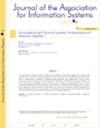三级模型发展指南:在信息系统研究中衔接分析层次和整合上下文影响
IF 5.5
3区 管理学
Q1 COMPUTER SCIENCE, INFORMATION SYSTEMS
引用次数: 0
摘要
多层次分析在信息系统(IS)研究中的应用稳步增加。许多研究都在将两层模型整合到他们对IS现象的研究中,这是一项令人钦佩的工作。然而,两层模型在使研究人员能够(1)更明确地将背景纳入理论发展和测试以及(2)通过关注连接层次上的远端分析水平的干预机制来弥合微观和宏观研究之间的现有差距方面是有限的。三层模型已经成为解决这些限制的潜在方法。虽然文献已经清楚地概述了如何估计三层模型的机制,但关于何时以及如何将这些模型的使用与理论发展结合起来的指导很少,如果有的话。因此,IS研究人员几乎没有指导,以告知他们如何将三层模型的使用与他们的理论发展和测试相结合。在本文中,我们确定了IS研究人员应该考虑使用三层模型的情况,制定了如何将三层模型估计的使用映射到理论目标的指导方针,并提供了如何实施指导方针的说明。本文章由计算机程序翻译,如有差异,请以英文原文为准。
Guidelines for the Development of Three-Level Models: Bridging Levels of Analysis and Integrating Contextual Influences in IS Research
The use of multilevel analysis has steadily increased in information systems (IS) research. Many studies are doing an admirable job of integrating two-level models into their examination of IS phenomena. However, two-level models are limited in how well they enable researchers to (1) more explicitly incorporate context into theory development and testing and (2) bridge the existing gap between micro- and macrolevel research by focusing on intervening mechanisms that link hierarchically distal levels of analysis. Three-level models have emerged as a potential way to address these limitations. While the literature has clearly outlined the mechanics of how to estimate three-level models, there is very little, if any, guidance on when and how to integrate the use of such models with theory development. Consequently, IS researchers have little guidance to inform their decisions about integrating the use of three-level models with their theory development and testing. In this article, we identify the circumstances under which IS researchers should consider the use of three-level models, develop guidelines about how to map the use of three-level model estimation to the theoretical objectives, and provide an illustration of how to implement the guidelines.
求助全文
通过发布文献求助,成功后即可免费获取论文全文。
去求助
来源期刊

Journal of the Association for Information Systems
工程技术-计算机:信息系统
CiteScore
11.20
自引率
5.20%
发文量
33
审稿时长
>12 weeks
期刊介绍:
The Journal of the Association for Information Systems (JAIS), the flagship journal of the Association for Information Systems, publishes the highest quality scholarship in the field of information systems. It is inclusive in topics, level and unit of analysis, theory, method and philosophical and research approach, reflecting all aspects of Information Systems globally. The Journal promotes innovative, interesting and rigorously developed conceptual and empirical contributions and encourages theory based multi- or inter-disciplinary research.
 求助内容:
求助内容: 应助结果提醒方式:
应助结果提醒方式:


